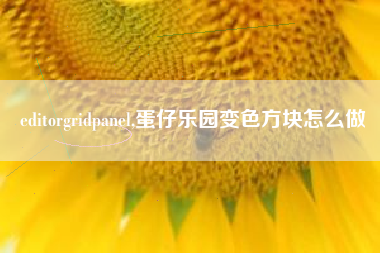editorgridpanel,蛋仔乐园变色方块怎么做?
你好,蛋仔乐园变色方块是一款益智类的游戏,玩家需要通过点击方块来改变它们的颜色,使得整个游戏界面上的方块都变成同一种颜色。具体制作步骤如下:

1. 创建游戏场景:打开Unity引擎,创建一个新的2D项目,然后在场景中创建一个Canvas对象。
2. 添加UI元素:在Canvas对象下创建一个Panel对象,并将Panel的RectTransform的Anchor设置为中心点,大小设置为1000x1000。然后在Panel对象下创建一个GridLayout Group对象,并将Cell Size设置为100x100。
3. 创建方块预制体:创建一个方块的预制体,大小为100x100,颜色为灰色。然后将该预制体拖入到GridLayout Group对象中,使得GridLayout Group自动地将方块排列在Panel中。
4. 编写代码:编写脚本代码,实现方块的颜色变换功能。具体实现过程为:当玩家点击一个方块时,将该方块的颜色改变为随机的一种颜色。然后检查该方块的上下左右是否与它的颜色相同,如果是则将它们的颜色也改变为随机的一种颜色。这样递归进行,直到整个游戏界面上的方块都变成同一种颜色为止。
5. 测试游戏:在Unity中点击运行按钮,测试游戏的功能。如果游戏正常运行,则可以进行更多的优化和改进。
以上就是制作蛋仔乐园变色方块的基本步骤,如果你对Unity引擎和游戏开发有一定的了解,可以根据这个基础来进行更加复杂和有趣的游戏开发。
eclipse网格布局怎么使它靠左边?
件所在的单元格来实现靠左对齐。
具体方法如下:
将该组件添加到容器中
在创建组件时,设置组件所在的单元格的属性
例如:GridBagConstraints c = new GridBagConstraints(); c.gridx = 0; //横向位置为0 c.gridy = 0; //纵向位置为0 c.anchor = GridBagConstraints.WEST; //将组件靠左边对齐
将该组件添加到容器中,并设置该组件的约束条件
例如:panel.add(component, c);
其中,c.anchor = GridBagConstraints.WEST;这一代码会将组件水平靠左对齐。
用java语言编写一个计算器有代码并有详解?
下面文件名要为:
JiSuanQi.java
import java.awt.*;
import java.awt.event.*;
public class JiSuanQi
{
String s="",s1=null,s2=null;
Frame f=new Frame("计算器");
TextField tf=new TextField(30);
Panel p1=new Panel();
Panel p2=new Panel();
Panel p3=new Panel();
Button bt1=new Button("=");
Button bt2=new Button("删除");
Button[] bt=new Button[16];
int id=0;
public static void main(String[] args)
{
new JiSuanQi().init();
}
public void init()
{
f.setBackground(new Color(85,247,253));
f.setLayout(new BorderLayout(4,4));
p2.setLayout(new GridLayout(4,4,4,4));
p3.setLayout(new BorderLayout(4,4));
f.setResizable(false);
f.add(p1,BorderLayout.NORTH);
f.add(p2);
p3.add(bt2,BorderLayout.NORTH);
p3.add(bt1);
p1.add(tf);
f.add(p3,BorderLayout.EAST);
String[] b={"1","2","3","+","4","5","6","-","7","8","9","*","0",".","复位","/"};
for(int i=0;i<16;i++)
{
bt[i]=new Button(b[i]);
p2.add(bt[i]);
}
bt[0].setForeground(Color.blue);
bt[1].setForeground(Color.blue);
bt[2].setForeground(Color.blue);
bt[4].setForeground(Color.blue);
bt[5].setForeground(Color.blue);
bt[6].setForeground(Color.blue);
bt[8].setForeground(Color.blue);
bt[9].setForeground(Color.blue);
bt[10].setForeground(Color.blue);
bt[12].setForeground(Color.blue);
bt[13].setForeground(Color.blue);
bt[3].setForeground(Color.red);
bt[7].setForeground(Color.red);
bt[11].setForeground(Color.red);
bt[15].setForeground(Color.red);
bt[14].setForeground(Color.red);
bt1.setForeground(Color.red);
bt2.setForeground(Color.red);
f.pack();
f.setVisible(true);
f.addWindowListener(new WindowAdapter()
{
public void windowClosing(WindowEvent e)
{
System.exit(0);
}
}
);
bt[0].addActionListener(new ActionListener()
{
public void actionPerformed(ActionEvent e)
{
s+=1;
s2+=1;
tf.setText(s);
}
}
);
bt[1].addActionListener(new ActionListener()
{
public void actionPerformed(ActionEvent e)
{
s+=2;
s2+=2;
tf.setText(s);
}
}
);
bt[2].addActionListener(new ActionListener()
{
public void actionPerformed(ActionEvent e)
{
s+=3;
s2+=3;
tf.setText(s);
}
}
);
bt[4].addActionListener(new ActionListener()
{
public void actionPerformed(ActionEvent e)
{
s+=4;
s2+=4;
tf.setText(s);
}
}
);
bt[5].addActionListener(new ActionListener()
{
public void actionPerformed(ActionEvent e)
{
s+=5;
s2+=5;
tf.setText(s);
}
}
);
bt[6].addActionListener(new ActionListener()
{
public void actionPerformed(ActionEvent e)
{
s+=6;
s2+=6;
tf.setText(s);
}
}
);
bt[8].addActionListener(new ActionListener()
{
public void actionPerformed(ActionEvent e)
{
s+=7;
s2+=7;
tf.setText(s);
}
}
);
bt[9].addActionListener(new ActionListener()
{
public void actionPerformed(ActionEvent e)
{
s+=8;
s2+=8;
tf.setText(s);
}
}
);
bt[10].addActionListener(new ActionListener()
{
public void actionPerformed(ActionEvent e)
{
s+=9;
s2+=9;
tf.setText(s);
}
}
);
bt[12].addActionListener(new ActionListener()
{
public void actionPerformed(ActionEvent e)
{
s+=0;
s2+=0;
tf.setText(s);
}
}
);
bt[13].addActionListener(new ActionListener()
{
public void actionPerformed(ActionEvent e)
{
s+='.';
s2+='.';
tf.setText(s);
}
}
);
bt[3].addActionListener(new ActionListener()
{
public void actionPerformed(ActionEvent e)
{
s1=s;
s+='+';
id=1;
s2="";
tf.setText(s);
}
}
);
bt[7].addActionListener(new ActionListener()
{
public void actionPerformed(ActionEvent e)
{
s1=s;
s+='-';
id=2;
s2="";
tf.setText(s);
}
}
);
bt[11].addActionListener(new ActionListener()
{
public void actionPerformed(ActionEvent e)
{
s1=s;
s+='*';
id=3;
s2="";
tf.setText(s);
}
}
);
bt[14].addActionListener(new ActionListener()
{
public void actionPerformed(ActionEvent e)
{
s="";
s2="";
tf.setText(s);
}
}
);
bt[15].addActionListener(new ActionListener()
{
public void actionPerformed(ActionEvent e)
{
s1=s;
s+='/';
id=4;
s2="";
tf.setText(s);
}
}
);
bt1.addActionListener(new ActionListener()
{
public void actionPerformed(ActionEvent e)
{
if(id<1) ;
else{
s+='=';
Double a=Double.parseDouble(s1);
double b=Double.parseDouble(s2);
double c=0;
switch(id)
{
case 1:c=a+b; break;
case 2:c=a-b; break;
case 3:c=a*b; break;
case 4:c=a/b; break;
}
s+=c;
tf.setText(s);
}
s="";s1="";s2="";id=0;
}
}
);
bt2.addActionListener(new ActionListener()
{
public void actionPerformed(ActionEvent e)
{
char[] c1;
char[] c2=new char[s.length()-1];
c1=s.toCharArray();
for(int i=0;i<s.length()-1;i++)
c2[i]=c1[i];
s=s.valueOf(c2);
if(id<1)
{
s1=s;
}
if(s2.length()>=1)
{
char[] c3;
char[] c4=new char[s2.length()-1];
c3=s2.toCharArray();
for(int i=0;i<s2.length()-1;i++)
c4[i]=c3[i];
s2=s2.valueOf(c4);
}
tf.setText(s);
}
}
);
}
}
在窗体中如何设置rgb?
1、用到的JFrame类的对象frame的方法:frame.setLayout(); 设置框架布局格式,有frame.setLayout(new GridLayout(5,1));为网格布局格式
frame.setSize(); 设置窗体大小
frame.add(); 添加组件到窗体内
frame.setVisible(); 设置窗体是否可见
2、所用到的JPanel类对象的方法:(这里设pColor是JPanel类的对象)
pColor.setBackground(); 设置面板的背景颜色
3、所用到的JLabel类对象的方法:(这里设是label是JLabel类的对象)
label.setText(); 设置标签里显示的内容
为什么一提到java的swing和awt组件?
早期的java主要是应用在web开发方面,所以从实用的角度出发,确实可以略过AWT和Swing的学习。在移动端开发流行之后,AWT和Swing又成为一个必修的内容了,因为做Android开发如果有一定的AWT基础是比较好的,很多概念是统一的。
为了描述这个问题,我们首先要了解到底什么是AWT,什么是Swing,以及它们与Android开发有什么联系。
AWT与Swingjava语言第一个支持图形界面开发的API就是AWT,在AWT中定义了java图形界面的很多核心概念,所以要了解java的图形界面开发方式一定要从了解AWT开始。下面分别介绍一下AWT中的三个核心概念:容器、组件、布局。
图形容器是存放图形元素的场所和环境,java中把容器分为顶级容器和次顶级容器。顶级容器可以单独显示、次顶级容器不能单独显示。顶级容器的代表是Frame,次顶级容器的代表是Panel。
图形组件是具体的图形应用元素,比如Button(按钮)、TextField(文本框)、Label(标签)、Choice(下拉列表)等等,每一个图形组件代表一种具体的图形应用元素。
布局的作用是安排图形组件在容器中的排列样式,常见的布局方式有BorderLayout、FlowLayout和GridLayout等。其中BorderLayout是Frame的默认布局管理器,FlowLayout是Panel的默认布局管理器。
具体的图形开发根据不同的界面设计采用不同的容器、布局和组件进行搭配组合,复杂的图形组件遵循顶级容器嵌套次顶级容器的方式来完成。
Swing与AWT相比较最大的优点是轻量级方式,Swing不依赖于本地操作系统,所以在样式上能够进行统一。在写法上采用了在AWT的类名基础上增加一个大写的J字符,比如在AWT中的Frame改为JFrame,Button改为JButton等等。
在实际的开发中比较推荐使用Swing的方式,一个原因是Swing的组件在外观上更具备科技感,另一个原因是它占用的资源较AWT更少。
事件处理说到AWT和Swing一定要说一下图形组件的事件处理方式,Java中的事件处理方式采用了监听的方式,也可以称为“代理”的方式。事件处理类通过实现具体的接口来完成对应的事件处理,比如ActionEvent对应的ActionListener接口;KeyEvent对应的KeyListener接口;MouseEvent对应的MouseListener接口和MouseMotionListener接口;WindowEvent对应的WindowListener接口等等。
这种处理方式让图形界面类和事件处理类进行了有效的分离,在代码处理上更加方便和灵活,在Swing的很多组件中也遵循了MVC的结构,让代码更加容易模块化。
总的来说java中的事件处理并不复杂,通过一定的实验就能完全掌握,所有这并不是学习的负担。
AWT与Android开发的关系传统的java图形处理方式并不完全适用于Android开发,在Android开发中通常采用配置文件的方式来完成Activity的创建,当然也可以使用代码的方式来完成Android的界面开发。
不管使用哪种方式来创建Android界面,大体的概念是一致的,比如布局、组件等等,只不过名称上有所区别,比如AWT中的Flowlayout对应于Android的布局是LinearLayout等,虽然名称不同但是概念是一致的。
事件处理方式也是大体一致,不过android开发中提供了基于回调的事件处理方式,这种方式在做一些简单的事件处理时比较方便。
所以如果将来要从事Android开发还是建议系统地学习一下AWT或Swing。
关注我,学习更多关于java开发的内容。

还没有评论,来说两句吧...